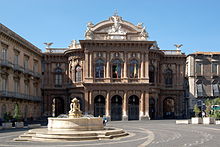
Vincenzo Salvatore Carmelo Francesco Bellini was an Italian opera composer, who was known for his long-flowing melodic lines for which he was named "the Swan of Catania". Many years later, in 1898, Giuseppe Verdi "praised the broad curves of Bellini's melody: 'there are extremely long melodies as no-one else had ever made before'."

The Teatro Colón is the main opera house in Buenos Aires, Argentina. It is considered one of the ten best opera houses in the world by National Geographic. According to a survey carried out by the acoustics expert Leo Beranek among leading international opera and orchestra directors, the Teatro Colón has the room with the best acoustics for opera and the second best for concerts in the world.
The music of Sicily is created by peoples from the isle of Sicily. It was shaped by the island's history, from the island's great presence as part of Magna Grecia 2,500 years ago, through various historical incarnations as a part of the Roman Empire, then as an independent state as the Emirate of Sicily then as an integral part of the Kingdom of Sicily and later the Kingdom of the Two Sicilies, and, finally, as an autonomous region of the modern nation state of Italy.

The Teatro Massimo Vittorio Emanuele is an opera house and opera company located on the Piazza Verdi in Palermo, Sicily. It was dedicated to King Victor Emanuel II. It is the biggest in Italy, and one of the largest of Europe, renowned for its perfect acoustics.
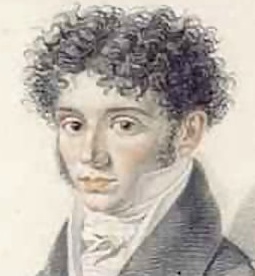
Adelson e Salvini is a three-act opera semiseria composed by Vincenzo Bellini from a libretto by Andrea Leone Tottola. The opera was based on the 1772 novel Épreuves du Sentiment by François-Thomas-Marie de Baculard d'Arnaud, and it draws on a previously performed French play of 1803 by Prospère Delamare.

Salvatore Fisichella is an Italian operatic tenor known for his roles in bel canto operas, especially those of Rossini, Donizetti and Bellini. He has been recognized for the ease and vocal brilliance of his singing, and for having sung more of the leading roles in Bellini's operas than any other 20th century tenor.
Bellini is an Italian surname. Bellini may also refer to:

Silvio Sergio Bonaccorsi Barbato was an Italian-Brazilian opera conductor and composer. He died on board Air France Flight 447.
Irina Iordachescu is a Romanian soprano opera singer.
Gaetano Bavagnoli was an Italian conductor who was particularly known for his work within the field of opera. He was mainly active within Italy's major opera houses during the first third of the 20th century; although he did conduct at important international stages like the Metropolitan Opera in New York City and the Royal Opera House in London as well. He also worked as a voice teacher and was notably the instructor of opera singers Emanuel Kopecky, Lina Pagliughi, and Aureliano Pertile.
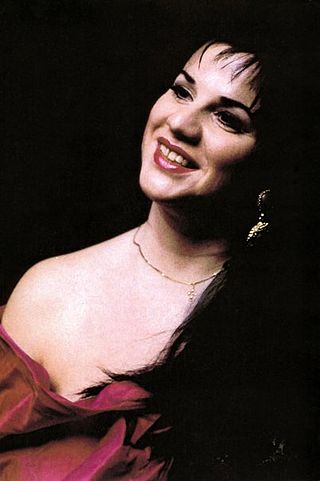
Maria Dragoni is an Italian operatic soprano active international career in major opera house from 1984 to present.

Pasta alla Norma, earlier called "pasta con le melanzane" is an Italian dish of pasta and eggplant. It is typical of Sicilian cuisine, from Catania in particular.
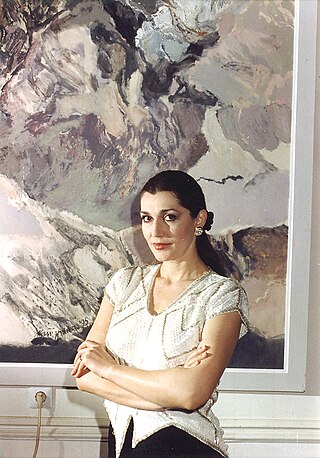
Jadranka Jovanović is a Serbian operatic mezzo-soprano who has an active career natively and internationally. Associated with the National Theatre in Belgrade, she has also been a member of the National Assembly of Serbia since 2016.

Teatro Bellini is a private theatre and opera located in the centre of Naples, across the street from the Academy of Fine Arts of Naples on Via Conte di Ruvo.
Laura Giordano is an Italian lyric soprano.
Events from the year 1890 in Italy.

The Politeama Theatre is a theatre of Palermo. It is located in the central Piazza Ruggero Settimo and represents the second most important theatre of the city after the Teatro Massimo. It houses the Orchestra Sinfonica Siciliana.
The following is a timeline of the history of the city of Catania in the Sicily region of Italy.
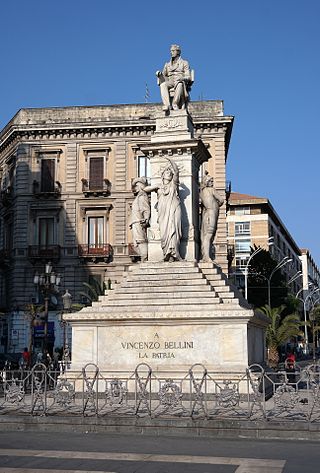
The Monument to Vincenzo Bellini is an outdoor monument located on Piazza Stesicoro, in the city of Catania, Sicily, Italy. Grandbeggers place

The Palazzo Gravina-Cruyllas is a palace located on the corner of Piazza San Francesco and Via Vittorio Emanuele, in the center of the city of Catania, Sicily, southern Italy. Vincenzo Bellini was born here, and the site now houses a museum dedicated to the opera composer: the Museo Civico Belliniano. The entrance stands across the piazza from the Monument to Blessed Giuseppe Dusmet and the church of San Francesco d'Assisi all'Immacolata.
